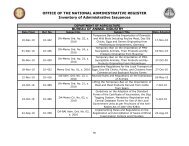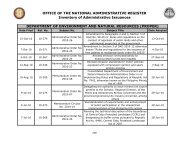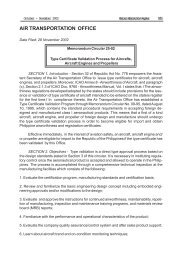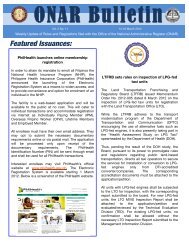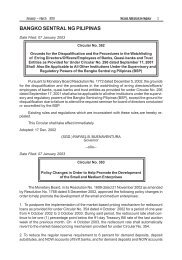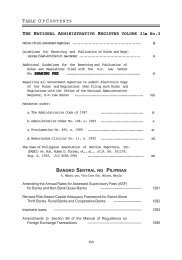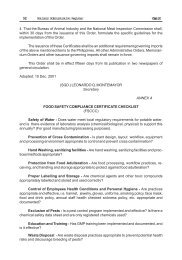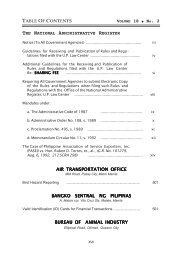Dr. Toby C. Monsod
Dr. Toby C. Monsod
Dr. Toby C. Monsod
You also want an ePaper? Increase the reach of your titles
YUMPU automatically turns print PDFs into web optimized ePapers that Google loves.
Low income housing:<br />
achievement, costs,<br />
challenges<br />
<strong>Toby</strong> C. <strong>Monsod</strong><br />
UP School of Economics<br />
3 February 2010<br />
for posting 020810 1
Preliminaries<br />
A functioning housing market: HH can translate their<br />
notional demand for quality housing into effective demand<br />
at market prices, and where the supply of housing is<br />
responsive to that demand.<br />
Housing is a private good but subject to significant market<br />
failures, especially at the bottom end, which is an<br />
economic rationale for both intervention and social<br />
provision. Also: equity, minimum housing standards<br />
Range of options: regulations, taxes/subsidies, direct<br />
provision. But government failure could be worse than<br />
market failures.<br />
for posting 020810 2
State policy thru the years<br />
1 st quarter 1900s: punitive, “clean up” Manila (slum<br />
clearance, sanitation and building codes)<br />
’30s – ‘50s : public housing investments in behalf of<br />
labor (e.g. Vitas, Diliman)<br />
‘60s – ‘70s: housing as strategic economic activity;<br />
subsidized and non-subsidized sector; public housing<br />
corporations (e.g. Tenement Act, Sapang<br />
Palay/Carmona, Quezon City housing projects)<br />
for posting 020810 3
1975/1986 onwards: National shelter<br />
program<br />
Goal: increase access to decent, affordable and secure<br />
shelter<br />
Who: bottom 30%, 40% or 50%; living in urban, or<br />
both urban and rural areas<br />
What: house, lot, or both<br />
Featuring: interacting network of housing agencies<br />
(HUDCC, NHA, HLURB, HGC, NHMFC, SHFC) +<br />
Pagibig, SSS and GSIS<br />
for posting 020810 4
Achievements: 2 million HH assisted<br />
from 1987-2007<br />
= 29% of backlog; 49% of target<br />
~ 20% (403, 215 HH): direct production, e.g.<br />
resettlement, slum upgrading, sites and services<br />
and other projects<br />
~ 26% (543, 976 HH): tenurial assistance or<br />
community-based mortgage finance<br />
~ 54% (1,106,492 HH): individual mortgage<br />
finance<br />
for posting 020810 5
Table 1: Estimated Backlog, Targets and<br />
Households served 1987 to 2007(In ‘000s)<br />
1 9 8 7 - 9 21 9 9 3 - 9 81 9 9 9 - 0 02 0 0 1 - 0 42 0 0 5 - 0 7T O T A L<br />
E st i m a t e d N e3 e, d3<br />
7 6 3 , 7 2 4 3 , 3 6 2 3 , 6 0 0 1 , 8 2 5 1 5 , 8 8 7<br />
B a c k l o g ( y e a r 1 , 0 1) 8 2 2 , 2 2 5 1 , 1 3 9 2 , 0 6 9 5 8 5 7 , 2 0 0<br />
P h y si c a l t a r g e6 t2<br />
7 1 , 2 0 0 4 7 8 1 , 2 0 0 6 6 4 4 , 1 6 9<br />
H H S e r v e d 2 7 8 6 6 9 2 2 9 4 8 3 3 9 5 2 0 5 4<br />
% T a r g e t 4 4 . 3 5 5 . 8 4 7 . 9 4 0 . 3 5 9 . 5 4 9 . 3<br />
% E st i m a t e d B a2 c3 k. l5 o g 3 0 . 1 2 0 . 1 2 3 . 3 6 7 . 5 2 8 . 5<br />
Backlog: units with double occupancy (urban & rural); units for tenure, infra<br />
or structural upgrading; units for replacement due to danger area/infra<br />
area/for eviction or demolition; homeless.<br />
Estimated Need: Backlog + projected new HH from population growth<br />
for posting 020810 6
Costs: Fiscal and quasi-fiscal costs,<br />
leakages, stunted markets<br />
Housing finance: Record not good. Collapsed in 1985, again<br />
in 1996<br />
Llanto, et. al [1997]: from 1995-97, 25 B in subsidies of<br />
which 90% were off-budget<br />
WB [1997]: recap of NHMFC + provisioning for Funds =<br />
P 55 B<br />
Housing Production: Record not good. high attrition rates in<br />
resettlement sites (as experienced in the 1950s), large<br />
inventory of unoccupied housing units<br />
Crowding out of private sector on both finance and real<br />
side<br />
for posting 020810 7
Good news: recent attempts at reform<br />
Development of Poor Urban Communities Sector Project<br />
(DBP and HUDCC), to pilot:<br />
Market-based shelter financing (MFI on lending DBP<br />
loans at market rates) + up front capital subsidies<br />
Rights-based tenurial instruments<br />
LGU as borrower or guarantor<br />
Railway Resettlement Projects (NHA)<br />
Innovation: in city/in-town policy; Local Inter-Agency<br />
Committee<br />
NHA as catalyst rather than direct provider<br />
for posting 020810 8
However, blind spot remains<br />
While the focus has been on maximizing the output of<br />
new houses and selling these at below-market prices, the<br />
fundamental causes of unaffordability on the supply side<br />
have remained largely unaddressed. Particularly<br />
dysfunctions in land markets.<br />
“The housing dilemma is primarily a land problem” [Roxas<br />
1969]<br />
“If (land) prices were as low in comparable developing<br />
countries… as much as 50% more shelter could have been<br />
built and fewer than 28 % of households would probably<br />
live under irregular tenure arrangements.” [Strassman and<br />
Blunt 1993]<br />
for posting 020810 9
Evidence from international experience: the<br />
establishment and strengthening of land and<br />
property market institutions is a prerequisite<br />
“The establishment and strengthening of land and<br />
property market institutions—including secure property<br />
rights, flexible land use regulations, and ease of land<br />
conversion, — is not easy. But without the commitment<br />
to such institutions, and without investment in connective<br />
infrastructure, targeted interventions to integrate slums<br />
are unlikely to work.” [WDR 2009, Chapter 7,emphasis<br />
added]<br />
More generally: spatially blind institutions and spatially<br />
connective infrastructure are prerequisites for successful<br />
interventions<br />
for posting 020810 10
Prioritizing and sequencing of policies<br />
is critical<br />
Sequence: “… spatially blind measures to create<br />
conditions suitable for economic concentration,<br />
followed by connective policies to deal with<br />
congestion” (WDR)<br />
Other spatially blind institutions:<br />
Basic social services to all<br />
Regulations for housing finance.<br />
for posting 020810 11
On “spatially connective<br />
infrastructure”<br />
In-country evidence on spatially connective<br />
infrastructure: Infrastructure, particularly transport,<br />
exerts both an indirect and direct effect on poverty<br />
reduction (Balisacan, et. al [2008])<br />
for posting 020810 12
Transport, exerts both an indirect and direct effect on poverty<br />
reduction (Balisacan, et. al. [2008])<br />
Explanatory variable<br />
Mean income growth<br />
Initial conditions<br />
Log (Per capita income 1988)<br />
Mortality rate<br />
Inequality<br />
Inequality squared<br />
Ethnic fragmentation<br />
Dynasty<br />
Time-varying policy variables<br />
Change in literacy<br />
Change in electricity<br />
Change in road density<br />
Change in CARP<br />
Change in ag. TOT<br />
Adj. R-squared<br />
Mean income<br />
growth<br />
–<br />
–<br />
–<br />
–<br />
+<br />
+<br />
+<br />
+<br />
+<br />
0.628<br />
Rate of poverty<br />
reduction<br />
–<br />
0.649<br />
for posting 020810 13<br />
–<br />
–
On “spatially connective<br />
infrastructure”…<br />
However, status:<br />
Level of investment: below par<br />
“Missing link”: provincial roads<br />
Bias for international connections versus domestic<br />
transport networks and corridors ⇒ enclaves<br />
As a stimulus, building domestic connective network is<br />
likely to generate more productive jobs and reduce<br />
poverty than direct government production of public<br />
housing<br />
for posting 020810 14
Proposition 1<br />
The integration of informal settlements a key component of urban<br />
and development policy. Low-income housing a key component<br />
of social policy.<br />
However, without the pre-requisite fluid land markets and domestic<br />
connective infrastructure, direct state interventions to address<br />
low income housing problems – for post-ondoy or otherwise –<br />
are likely to be ineffective and wasteful as they have in the past<br />
More precisely, to be successful, state strategy relating to low<br />
income housing needs to be embedded in a coherent and explicit<br />
urbanization framework. The prerequisites for inclusive<br />
urbanization are the same for successful low-income housing<br />
policy.<br />
for posting 020810 15
Proposition 2: once costs are<br />
contained on the supply side…<br />
Housing social assistance, when warranted, needs to be<br />
i. on-budget (transparent),<br />
ii. de-linked from market-based transactions, and<br />
iii. Evaluated vis education, health, and other<br />
components of social policy.<br />
for posting 020810 16
Design for subsidy policy: household-based,<br />
tenure neutral, allowing for self-selection.<br />
Type 1: Moderate to low-income HH who are at fringe of formal housing<br />
finance market. Options:<br />
lump-sum down-payment support<br />
mortgage buy-downs<br />
mortgage default insurance<br />
Type 2: HH for whom income, employment, collateral or other constraints<br />
make access to formal finance and housing infeasible. Options:<br />
upfront capital grant or rental subsidies<br />
serviced lot with core house as upfront subsidy, with assistance<br />
tied to savings mechanisms<br />
But if costs are not contained on supply side, demand side subsidies will<br />
simply be paying for inefficiencies.<br />
for posting 020810 17
Implications<br />
1. Move discussion of urban-rural linkages and<br />
management of urbanization strategy to provincial and<br />
sub-region level. Managing a portfolio of ‘places’, including<br />
chartered cities.<br />
Metro arrangements?<br />
1. Re-focus central agencies/NG away from direct housing<br />
assistance/production targets to –<br />
Explicit urban policy (framing MTPDP)<br />
Resolving bottlenecks in land markets (administration<br />
bottlenecks, articulate land/land use policy, inventory of<br />
public land) and credit markets<br />
Connecting the domestic economy; addressing “missing<br />
links” in domestic infra and building density<br />
Ensuring policy predictability and guarantees, tenure neutral<br />
policies<br />
for posting 020810 18
3. City/municipalities to focus on:<br />
local planning, embedded in larger “area” planning<br />
local land use regulations and removing admin bottlenecks<br />
in land administration (which will enable private sector)<br />
Property taxes<br />
Basic health and education services to all<br />
Local transportation and connective infrastructure<br />
And, when a certain level of urbanization is reached, targeted<br />
social assistance (not direct or subsidized housing finance!), e.g.<br />
Servicing of land for settlements<br />
Local rental housing policies, subsidies?<br />
for posting 020810 19
“Post-ondoy” rehab issues provides opportunity<br />
to reframe low-income housing debate<br />
From the “cart before the horse” ⇒ embed<br />
housing in explicit urbanization policy.<br />
From a focus on “in-situ vs relocation?”, “in-city<br />
vs. off-city?” “single house or MRB?” ⇒<br />
discussion of transport, land market<br />
interventions, the efficiency and inclusiveness of<br />
processes that will reconfigure the greater MM<br />
area.<br />
for posting 020810 20



